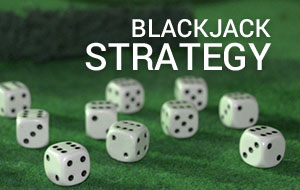
Blackjack is a game where the player’s decision directly impacts the result.
Do you hit? Or do you stand? Or should you double down? Is the hand you have the right one to split?
Or should you just surrender?
All that and more you know easily thanks to blackjack strategy.
One of the things about blackjack pairs strategy is that it is not based on assumptions but comes with mathematical proof.
Basic Blackjack Strategy
The first step towards learning to play blackjack and winning is to learn basic blackjack strategy. Basic strategy helps in another big way: it could help bring the house edge down to 0.5% or even lower! Of course this happens with dependencies – the number of card decks, the table rules for the game, and so on. It may not be an automatic guarantee of a reduced house edge but it does help you figure out your game.
Small video showing some of the basic strategies:
The basic strategy differs depending on a number of factors. These include:
- The blackjack game the player is playing (also see tips for blackjack).
- The number of card decks in use in the game.
Basic Strategy for Single Deck Blackjack
Here are a couple of rules to follow regarding basic strategy for single-deck blackjack:
- Do not opt for the insurance bet as it raises the house edge to a high 5.9% in single-deck blackjack.
- If you are not able to re-split a hand treat it as a hard total hand and follow the strategy for that hand as per the tables below.
The basic strategy for single deck blackjack depends mainly on a few factors:
- Whether the dealer stands or hits on a hard 17
- Whether the dealer stands or hits on a soft 17.
- The kind of totals the player has for the rest of the hands:
- Hard totals
- Soft totals
- Pairs (hands that can be split)
We provide below the strategy for single-deck blackjack based on the player’s hand.
In the below table, the different elements stand for the following:
- H: Hit
- S: Stand
- P: Split
- DH: Double down if permitted, else Hit
- DS: Double down if permitted, else Stand
- PH: Split if doubling down is permitted after splitting, else Hit
- PD: Split if doubling down is permitted after splitting, else double down
- RH: Surrender if the option is available, else Hit
- RS: Surrender if the option is available, else Stand
Basic Strategy for Single Deck Blackjack: Dealer Hits on Soft 17

Basic Strategy Chart for Single Deck Blackjack: Dealer Stands on Soft 17

In the blackjack strategy chart above, we have not provided separate rows for 5- and 10-pair hands as we have taken those hands as hard 10s and hard 20s and covered them in that corresponding table for hard hands.
Basic Strategy for Blackjack Using 4 to 8 Decks
 As we mentioned earlier, the house edge and the way the game plays out differs mainly depending on the number of card decks used. It is only natural, therefore, for the strategy to be different for multi-deck blackjack games compared to the strategy we provided earlier for single deck games.
As we mentioned earlier, the house edge and the way the game plays out differs mainly depending on the number of card decks used. It is only natural, therefore, for the strategy to be different for multi-deck blackjack games compared to the strategy we provided earlier for single deck games.
Here are a couple of rules to follow as part of strategy for blackjack using 4 to 8 decks:
- Do not play the insurance bet as it raises the house edge considerably.
- If a player cannot re-split a hand, the best option is to treat that hand as a hard total hand.
We list below the tables for basic strategy for blackjack games using 4 to 8 decks.
- H: Hit
- S: Stand
- P: Split
- DH: Double down if permitted, else Hit
- DS: Double down if permitted, else Stand
- PH: Split if doubling down is permitted after splitting, else Hit
- PD: Split if doubling down is permitted after splitting, else double down
- RH: Surrender if the option is available, else Hit
- RS: Surrender if the option is available, else Stand
Basic Strategy for 4 to 8-Deck Blackjack: Dealer Hits on Soft 17

Basic Strategy for Single Deck Blackjack: Dealer Stands on Soft 17

Wherever you do not find separate information for splitting a hand of 5-pair or 10-pair treat it as a hard hand (hard 10 and hard 20 respectively).
This may not seem like an advanced blackjack betting strategy but understanding the basics of how the betting systems work is as advanced as it can get. You can use the free welcome bonus to try out various casinos blackjack card strategies before using real money. If you play online most online gambling sites will give you a free deposit bonus.
Blackjack Strategy FAQ
Everything You’d Like to Know
Every player that aims to be successful at Blackjack should follow the simple, yet detailed Blackjack strategy. Here you’ll find all the answers you need.
What is Blackjack basic strategy?
Blackjack basic strategy is a set of rules and guidelines which allow you to maximize your winning odds. It is very hard, if not impossible, to make a profit playing Blackjack, especially in the long term, if you’re not employing the basic strategy. The basic strategy can be displayed either as a table (multiple tables) or as text. Players with a visual memory will prefer the table(s), whereas for others it might be easier to learn the textual version. The basic strategy tells you the smartest thing to do in any given situation.
What is the Blackjack basic strategy based on?
The basic strategy is based on a computer simulation. A computer program is set to play a very large number of hands and, through trial and error, it learns what should be done in a given situation. Bear in mind that the strategy is based on statistics and it only gives you the most viable option. There is no guarantee that you are going to win in each and every hand where you apply the strategy. However, you can be certain that you are more likely to win when you apply the strategy.
How should I apply the Blackjack strategy in practice?
If you can’t memorize the table as a whole, and you have trouble recalling what you should do in a given situation, then follow the following order of operations. First, ask yourself if you should surrender in that particular situation (if that is allowed). If the answer to that question is no, then think whether you should split (if that’s an option). Then, if you are not supposed to split, you ask yourself if you should double (where applicable). And finally, if you shouldn’t double, or if that’s not an option, you ask yourself whether you should hit or stand.
Does the number of decks influence the Blackjack strategy?
Yes, it does, as the number of decks changes the house edge, it also changes the strategy. Generally, fewer decks results in a lower house edge. However, most online casinos games use 4-8 decks, in some cases up to 9 and the same strategy can be used regardless whether there are 4, 6 or 8 decks, as the differences are insignificant and don’t influence the outcome of every hand in that amount so that a different strategy should be employed.
Are Blackjack games where the dealer stands on soft 17 different than ones where s/he stands on hard 17?
Yes, the rule whether the dealer is supposed to hit or stand on soft 17 does change the basic strategy. If you look tables for, say a six-deck game where the dealer stands on soft 17 and a one where the dealer is supposed to hit on soft 17, it might not seem like there are too many differences, but it can make a huge impact. If it is difficult for you to memorize both tables, it would be best to memorize the rules for the versions where the dealer stands on soft 17. The impact will be less negative, compared to the situation where you always apply the strategy for a game where the dealer hits on soft 17.
The Blackjack basic strategy doesn’t say anything about ‘Insurance’, why?
That is because you should never take insurance, it is a side bet that actually increases the house edge. Insurance is a bet which becomes available when the dealer’s face-up card is an ace. Basically with the insurance you get your original bet back if the dealer lands a Blackjack.
But, in order to activate it, you have to lay an additional amount, worth half your original bet. If the dealer doesn’t hit a Blackjack, you lose the additional insurance wager, but still have a chance to win the original wager. Insurance is a bad bet, because it is actually a bet that the dealer will get a Blackjack, and the odds for that to happen are 9:4 when his/her card is an ace, which means that you’ll lose more often than not.
What are the most important rules in the perfect Blackjack strategy?
All of the rules are very important, but perhaps you should aim to learn and remember the rules that which contain the word ‘always’ or ‘never’. For instance, it is more important to remember that you should always split aces, then to remember that you should split 4’s only when the dealer has 5 or 6. The reason is simple – it is more likely for you to be dealt two aces regardless of the dealer’s card, than to be dealt two 4’s against a dealer’s 5 or 6.
So, can I start playing Blackjack after I learn at least some of the rules of the basic strategy?
It is much wiser to learn the strategy in full and to memorize all the rules and situations before you start playing. Practice at home and start playing for real money only when you’re sure that you remember the entire table and know what to do in every situation.
Is the Blackjack strategy legal? Can I use it without fear of being suspended?
The Blackjack basic strategy is completely legal and players can memorize the rules and use the strategy when they are playing Blackjack. Casinos won’t through you out or ban you from playing if they realize that you’re using the strategy. In fact, every professional Blackjack player uses the strategy, it is simply how you play Blackjack.
Is there another Blackjack strategy, a more advanced one?
There can be a range of different Blackjack betting strategies, depending on the Blackjack variant in question. However, all Blackjacks strategies are based on the basic strategy. You can amend the basic strategy and adjust it to any type of Blackjack. So, for example, if a new version of Blackjack is invented tomorrow, you would still be able to adjust the basic strategy and apply it to it.
Resources:
- Casino licenses offed by : Gibraltar Gambling Commissioner , Government of Curacao , UK Gambling Commission , Alderney Commission , Nevada, New Jersey
